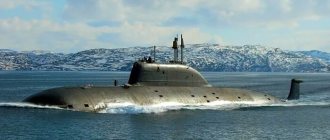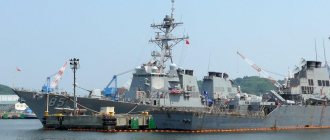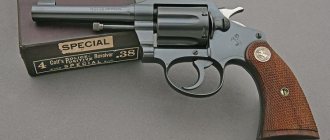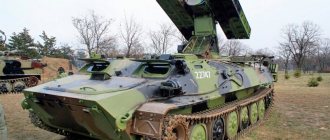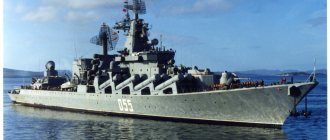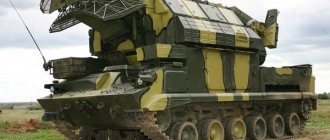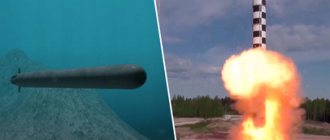The heavy nuclear-powered missile cruiser "Peter the Great" is the only ship of the "Orlan" generation in service and the world's largest attack warship of this series. Its main purpose is the uncompromising destruction of enemy aircraft carrier groups. This is the flagship ship of the Northern Fleet, the first of the ships of the Russian Navy to be awarded a high award in peacetime - the Order of Nakhimov.
In the fall of 2020, the Peter the Great, as part of a carrier-based carrier group headed by the aircraft-carrying cruiser Admiral of the Fleet of the Soviet Union Kuznetsov, together with the Severomorsk and Vice Admiral Kulakov and support vessels, set off on a long voyage to the areas of the northeastern Atlantic and the Mediterranean Sea. The cruiser returned to her home harbor only in February 2020, having covered 18 thousand nautical miles during that time.
Journalist Alexey Egorov will talk about what it’s like to be called and to be “Great”, what this ship is capable of at sea and what an updated, modernized cruiser of a similar project will be like in the next episode of the “Military Acceptance” program on the Zvezda TV channel.
Records of "Peter the Great"
Only aircraft carriers are larger than this ship in size. True, they do not have the same solid range of weapons. Today, this Russian cruiser holds the status of “the most powerful missile attack ship in the world.”
But these are not all the records worthy of mention in the Guinness Book. As the commander of the cruiser, Captain 1st Rank Vladislav Malakhovsky, notes, “Peter the Great” can circle the globe along the equator not once, not twice, but as many as 50 times in a row! The cruiser's power reserve is enough for exactly that distance, for that number of miles. At the same time, a colossus the height of a twenty-story building will constantly move along the sea surface at a speed of 32 knots per hour.
The cruiser of the same project as the Peter the Great, named Admiral Nakhimov, has yet to become operational in the Russian Navy. True, this ship has already sailed the seas, but today it is undergoing serious renovation. Its size is just as impressive as that of its “brother”. Height - 59 meters, length - 251 meters (two and a half football fields).
The closest “classmates” of these Russian ships are “smoking nervously” on the sidelines. Thus, the US Navy cruisers Virginia and Long Beach are two and a half and one and a half times smaller than Russian ones, respectively. At the same time, as our shipbuilders say, the Nakhimov’s cruising range will be practically unlimited, and the only limitation on autonomy will be the supply of food for the crew.
On the cruiser, which is to be put into operation, a new anti-aircraft missile system will be installed, a new life support system will be used, and new controls will be introduced.
…The history of “Peter the Great” is like a copy of the modern history of the country. The top officials of the state have been on board more than once, but the most important thing is that this ship was constantly involved in carrying out the most important tasks. It was he who ensured the safety of the removal of chemical weapons from the Syrian Arab Republic in 2014.
A working meeting of the Organization for the Prohibition of Chemical Weapons was then held on board the Russian cruiser. “Representatives of Russia, the USA, Great Britain, China, Denmark, and Syria were present,” recalls Vladislav Malakhovsky.
The cruiser also took part in skirmishes with real pirates! It happened in 2009, in the Indian Ocean. Russian marines, who were then on board the Peter the Great, captured the weapons of 21st century filibusters, their equipment for boarding ships, and communications equipment.
Construction[ | ]
It is the world's largest operational non-carrier strike combat ship as of 2020[4][5].
Basic performance characteristics[ | ]
- Length: 250.1 m.
- Width: 25 m (at the waterline)
- Height from the main plane: 59 m.
- Draft: 10.3 m (at the bow bulb)
- Standard displacement: 23,750 tons.
- Total displacement: 25,860 tons.
- Power plant: 2 nuclear reactors of the KN-3 type (300 MW), 2 auxiliary boilers, two turbines of 70 thousand liters each. With. (total 140 thousand hp), 4 power plants with a total capacity of 18 thousand kW, 4 steam turbine generators with a capacity of 3000 kW, 4 gas turbine generators of 1500 kW each, two propeller shafts.
- Speed: 32 knots (about 60 km/h).
- Navigation autonomy - 60 days for food and supplies, 3 years for fuel.
Hull and superstructure design[ | ]
The length of the ship's 49 corridors is more than 20 kilometers. The ship has 6 decks, 8 tiers. The height of the foremast from the level of the main plane is 59 meters.
Power plant[ | ]
The cruiser's powerful nuclear power plant allows it to reach a speed of 32 knots (60 km/h) and is designed to operate for 50 years[4]. For comparison: the cruiser “Peter the Great” is capable of providing electricity and heat to a city of 150-200 thousand inhabitants[4].
Crew[ | ]
The cruiser's crew is 1035 people (105 officers, 130 midshipmen, 800 sailors). They are located in 1,600 rooms of the ship, including 140 single and double cabins for officers and midshipmen, 30 cockpits for sailors and petty officers (for 8-30 people each), 220 vestibules. The crew has 15 showers, two baths, a sauna with a 6x2.5 m swimming pool, a two-level medical block with isolation hospitals, a pharmacy, X-ray and dental rooms, an outpatient clinic, an operating room, a gym equipped with exercise equipment, three wardrooms for midshipmen and officers and admirals, a lounge with billiards and a piano. There is also an in-ship television studio and 12 household televisions in cabins and cockpits, in addition to 30 monitors for viewing programs that are broadcast on the ship's cable networks.
Uncompromising "Granite"
Former commander of the warhead-5 cruiser "Admiral Nakhimov", and now an employee of "Sevmash", captain 1st rank of the reserve Viktor Kanishevsky is proud of the pilothouse of the unique ship. The glass here can withstand bullets, and an armored flap protects against artillery shells.
In fact, the cabin is a fortified caponier, a bunker, notes Victor. This is a real command post. And not only for the commander of a cruiser - for the commander of a division, squadron and even a fleet.
The capabilities of the ship's combat information center are also impressive. The commander of the radio-technical combat unit of the Peter the Great, Captain 3rd Rank Evgeniy Bobrovsky, draws attention to the fact that information about all types of situations flows here in real time: air, surface, underwater.
To classify targets, electronic reconnaissance data is used: the established coordinates of the same missile make it possible to destroy it on approach. "Peter the Great" is capable of detecting an AWACS aircraft, and it will do this before the aircraft detects it. The underwater situation is monitored no less clearly - three acoustic antennas located in the bow, under the keel and at the stern are responsible for this.
The main deck of the ship is a missile deck. Cruise missile launch silos and air defense systems are located here. The cruiser's main armament is the Granit anti-ship complex and 20 launchers. The length of each rocket is 10 meters, weight - 7 tons.
The warhead can be high explosive or nuclear. A Granit salvo is guaranteed to destroy an enemy air strike group. The strike scheme is constructed in an original way: 7-8 missiles take off in a salvo, one of which goes above the target and monitors the situation.
The rest go lower, and if the “commander missile” is shot down, then the next one takes control. In this way, a group of missiles is guaranteed to reach the target and deliver its strike.
Heavy nuclear-powered missile cruiser of the "Peter the Great" type, Project 1144.2
The heavy nuclear missile cruiser Project 1144.2 (code "Orlan") was developed by the Northern Design Bureau under the leadership of B.I. Kupensky, and then V.A. Perevalov and is an improved modification of TARKR pr.1144. In 1984, the second ship of Project 1144 (the first according to Project 1144.2) appeared - “Frunze (Admiral Lazarev)”, in 1988 the third - “Kalinin (Admiral Nakhimov)” and “Yuri Andropov (Peter the Great)” in 1998 - currently the flagship of the Northern Fleet.
The design of the hull and mechanisms of the ship completely replicates the prototype. All the differences concerned weapons. In accordance with the initial design, it was supposed to carry two Kinzhal air defense systems (each with two launchers, including 4 drums, instead of the Osa-MA air defense system), 6 Kortik air defense missile systems (instead of the AK-630M ZAK ), one twin 130mm AU (instead of two 100mm AU) and the Vodopad anti-aircraft missile system with RTPU (instead of the Metel anti-aircraft missile system and 533mm TA). However, due to delays in development and delivery, the weapons systems then available were installed on ships entering service. The Frunze TARKR was transferred to the fleet with the AK-630M ZAK without both Kinzhal air defense systems and six Kortik air defense missile systems. At the same time, the Osa-MA air defense system was retained. On the Kalinin TARKR, instead of the AK-630M ZAK, they installed the Kortik air defense system, and instead of the RBU-1000, they installed the Udav-1 anti-torpedo protection complex. TARKR "Yuri Andropov" was supposed to be put into operation with standard weapons. By the time it was launched, the S-300F Fort air defense system was upgraded into the S-300FM Fort-M air defense system with a new generation fire control system and missile defense system. In the mid-1990s, they decided to install this modification of the air defense system instead of the bow-mounted Fort air defense system. Also, the cruiser was armed with only one (stern) Kinzhal air defense system. Thus, at present, none of the cruisers of this type carries the weapons provided for in the original design. However, volumes and energy capacities are reserved for it on ships, so that if necessary, ships can be quickly rearmed.
The cruiser's armament is based on Granit P-700 (3M-45) anti-ship supersonic missiles. With a launch weight of 7 tons, the rocket develops a speed of 2.5 M and can deliver a high-explosive warhead weighing 750 kg or a nuclear charge with a power of up to 500 kt over a distance of 600 km. The warhead is a monoblock in nuclear, conventional (750 kg of explosive) equipment or a fuel-air warhead (volumetric explosion). The guidance system is inertial with a radio command system for adjusting the flight path and a warhead with an active radar homing system in the final section (at a distance of 37 km from the target). Anti-aircraft missile weapons are represented by three air defense systems: S-Z00F (S-Z00FM), “Dagger” and “Dirk”. They are creating a three-echelon air defense-missile defense system. In the near (last) air defense-missile defense zone, our ship is covered by the “barrels” of a 30-mm MZAK. In addition to anti-aircraft weapons for self-defense against low-flying anti-ship missiles, the cruiser is equipped with a universal AK-130 artillery system, providing a rate of fire from 20 to 86 rounds per minute. Its twin 130-mm artillery mount (AU) also makes it possible to fire at sea and coastal targets and support landing forces with fire. The ammunition has unitary rounds of several types, for example, high-explosive fragmentation with impact, remote and radio fuses.
In general, the domestic nuclear cruiser Project 1144.2 is significantly superior to its foreign (albeit built earlier, but designed almost simultaneously) analogues - ARKR of the Virginia and California types - in absolutely all main tactical-technical and military-economic indicators. If we exclude from consideration the very specific NK - AB - and American battleships put into reserve at the limit of their physical age (over 50 years), then without exaggeration we can say that our TARKR pr.1144 and 1144.2 are the most powerful and protected BHK not only in the domestic navy, but also in the world. It should be added that in the series of 4 ships, Project 1144 (1144.2), “Peter the Great” is the most advanced. The uniqueness of the ship is also enhanced by the fact that it is equipped with the only S-Z00FM air defense system in the Russian Navy - there are no other ships with such an air defense system in the fleet, and their arrival is not expected in the coming years. Overall, the Peter the Great is the world's largest non-aircraft-carrying attack warship. According to the commander-in-chief of the Russian Navy, Admiral Kuroyedov, the combat effectiveness of the Northern Fleet with the commissioning of the 21st century cruiser Peter the Great increased by 17 percent.
NATO considered the Soviet squadrons led by Project 1144.2 cruisers as very dangerous rivals for its aircraft carrier formations. During theoretical exercises, to destroy such a squadron, groups of four aircraft carriers were deployed, of which only one was supposed to remain afloat. The air groups of three aircraft carriers were supposed to be almost completely lost.
Design
It is the world's largest operational non-carrier strike combat ship as of 2020[4][5].
Basic performance characteristics
- Length: 250.1 m.
- Width: 25 m (at the waterline)
- Height from the main plane: 59 m.
- Draft: 10.3 m (at the bow bulb)
- Standard displacement: 23,750 tons.
- Total displacement: 25,860 tons.
- Power plant: 2 nuclear reactors of the KN-3 type (300 MW), 2 auxiliary boilers, two turbines of 70 thousand liters each. With. (total 140 thousand hp), 4 power plants with a total capacity of 18 thousand kW, 4 steam turbine generators with a capacity of 3000 kW, 4 gas turbine generators of 1500 kW each, two propeller shafts.
- Speed: 32 knots (about 60 km/h).
- Navigation autonomy - 60 days for food and supplies, 3 years for fuel.
Hull and superstructure design
The length of the ship's 49 corridors is more than 20 kilometers. The ship has 6 decks, 8 tiers. The height of the foremast from the level of the main plane is 59 meters.
Power plant
The cruiser's powerful nuclear power plant allows it to reach a speed of 32 knots (60 km/h) and is designed to operate for 50 years[4]. For comparison: the cruiser “Peter the Great” is capable of providing electricity and heat to a city of 150-200 thousand inhabitants[4].
Crew
The cruiser's crew is 1035 people (105 officers, 130 midshipmen, 800 sailors). They are located in 1,600 rooms of the ship, including 140 single and double cabins for officers and midshipmen, 30 cockpits for sailors and petty officers (for 8-30 people each), 220 vestibules. The crew has 15 showers, two baths, a sauna with a 6x2.5 m swimming pool, a two-level medical block with isolation hospitals, a pharmacy, X-ray and dental rooms, an outpatient clinic, an operating room, a gym equipped with exercise equipment, three wardrooms for midshipmen and officers and admirals, a lounge with billiards and a piano. There is also an in-ship television studio and 12 household televisions in cabins and cockpits, in addition to 30 monitors for viewing programs that are broadcast on the ship's cable networks.
History of construction
The missile cruiser "Peter the Great" was designed by the Northern Design Bureau. Construction work began at the Baltic Shipyard in 1986. At the initial stages of assembly, the ship was called “Yuri Andropov” and “Kuibyshev”. Launched in the spring of 1989. It acquired the name “Peter the Great” in 1992, and in 1998 it became part of the Northern Fleet. The ship's side number is 099. Over the 11 years of its existence, it has carried out sea voyages without being sent for factory repairs - service employees from industrial enterprises regularly work on the cruiser. Despite its long service life, the Peter the Great has a reliable hull, excellent ride quality and maneuverability, and a large displacement. In the future, the ship may undergo modernization. Moreover, the ship in the Northern Fleet has no analogues in the world.
Heavy nuclear missile cruiser Peter the Great
Cruiser commanders[edit | edit code]
A visit by the American delegation to the ship "Peter the Great" during the visit of the Chief of Staff of the US Navy Gary Roughhead (first row, far left) to Severomorsk, April 2011. In the first row, Admiral Roughhead and the acting commander of the CSF, Rear Admiral Volozhinsky, perform a military salute. In the background is the Admiral Levchenko BOD.
- Dobryshev Evgeniy Nikolaevich - captain 1st rank (First commander of the cruiser according to the Historical Journal, under his leadership the crew was formed in Vladivostok, the ship was completed in St. Petersburg and transferred to the Northern Fleet).
- Vasiliev Sergey Igorevich - captain 1st rank (under his leadership, state tests were passed and the flag was raised).
- Kasatonov Vladimir Lvovich - rear admiral (March 2000 - July 2005), now vice admiral, Deputy Commander-in-Chief of the Navy.
- Yakushev Vladimir Anatolyevich (2005-2008) - captain 1st rank, now rear admiral, commander of the Primorsky flotilla of diverse forces of the Pacific Fleet.
- Menkov Felix Vladimirovich - captain 1st rank.
- Malakhovsky Vladislav Vladimirovich - captain 1st rank.
- Nikitin Igor Aleksandrovich - captain 1st rank. [ source not specified 542 days
] - Kuzmin Vladimir Vyacheslavovich, captain 1st rank

